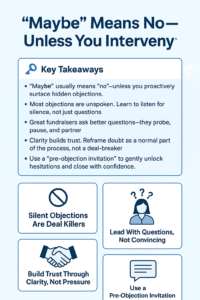Indecision, Surfacing Silent Concerns, and Getting Investors Off the Fence with Confidence
🔑 Key Takeaways
- “Maybe” usually means “no”—unless you proactively surface hidden objections.
- Most objections are unspoken. Learn to listen for silence, not just questions.
- Great fundraisers ask better questions—they probe, pause, and partner.
- Clarity builds trust. Reframe doubt as a normal part of the process, not a deal-breaker.
- Use the “pre-objection invitation” to gently unlock hesitations and close with confidence.
If you’ve been in the capital-raising game for long, you’ve heard some version of it a hundred times:
“This looks interesting. Let me think about it and get back to you.”
It sounds polite. It even feels promising. And in the moment, it’s tempting to walk away from that conversation thinking you’ve got a likely investor in your pipeline. But weeks pass, and that “maybe” slowly morphs into a quiet no. No email. No update. No investment.
What happened?
“Maybe” Means No—Unless You Intervene
Here’s the truth most capital raisers don’t want to hear: “maybe” is not a halfway point between yes and no. It’s usually a camouflage for unspoken concerns. Not always big ones—often, they’re small moments of hesitation, unanswered questions, or subtle misalignments that the investor doesn’t know how to articulate.
So instead of asking, they stall.
And unless you learn to surface these hidden objections early, you’ll lose countless deals in the space between interest and action.
Silent Objections Are Deal Killers
The challenge is that most objections don’t show up as arguments. They show up as silence, lack of clarity, or a polite deferral.
Investors don’t often say:
-
“I’m not sure if I trust you yet.”
-
“This deal feels too complicated.”
-
“What if this locks up my capital longer than I’m comfortable with?”
Instead, they just wait. And wait. And eventually, they fade.
Not because they weren’t interested, but because their uncertainty went unaddressed. And in high-trust transactions like syndications and private placements, uncertainty is the enemy of action.
This is where great fundraisers separate themselves from average ones.
-
They don’t just explain—they elicit.
-
They don’t just present—they probe.
-
And most importantly, they create an environment where investors feel comfortable naming their doubts without fear of judgment or pressure.
That starts not with a better pitch, but with better questions—asked with patience, empathy, and a genuine desire to understand what’s holding the investor back.
Want to see how the pros build trust and momentum without sounding pushy or salesy?
👉 Watch our free training here
Lead With Questions, Not Convincing
One of the most effective ways to draw out hidden objections is to simply pause after your pitch and ask:
“What concerns do you still have—either about the deal, the timing, or how it fits into your strategy?”
This kind of open-ended framing gives the investor permission to explore their own hesitation. You’re not forcing the issue; you’re giving them the space to process—and that’s often when the real decision-making begins.
But you can’t stop at the first layer.
Often, the initial response will be surface-level:
-
“I just need to look over the numbers again.”
-
“I’m comparing this with another opportunity.”
Your role is to dig a little deeper, gently.
Try:
-
“What would need to be true for this to feel like the right move for you?”
-
“When you picture making this kind of investment, what gives you confidence—and what gives you pause?”
These aren’t pressure questions. They’re reflection tools. And when used well, they shift the dynamic from seller vs. skeptic into guide and partner.
Build Trust Through Clarity, Not Pressure
This is your moment to explore Implication and Needs in real time.
You’re not just surfacing problems—they’ve already seen your deal, and the basics are clear. You’re helping them understand:
-
The impact of not moving forward
-
The benefit of solving a known gap
You might ask:
-
“If you waited on this and nothing else aligned in the next 6–12 months, what’s the cost of that delay?”
-
“What would it mean if this investment provided exactly the kind of income stream you’ve been trying to build?”
You’re not pitching. You’re painting context through their own words.
And sometimes, the objection isn’t even about the deal. It’s about the relationship.
They like the numbers, but they’re unsure if they trust you yet. They’re not used to this kind of structure. They’re worried about wiring six figures to someone they just met.
All valid.
Your job isn’t to overcome them. It’s to normalize them, name them, and offer structure that creates comfort:
-
A clear timeline
-
A simple commitment process
-
An invitation to ask questions—without being rushed
Because objections don’t kill deals.
Unspoken objections do.
Want help creating a trust-building investor process tailored to your deal?
📅 Schedule a consultation with our team
One Last Technique: The Pre-Objection Invitation
This one’s deceptively simple—and incredibly powerful.
Try saying:
“Most investors we work with have at least one or two sticking points before moving forward. It’s completely normal. Can I ask, what’s yours?”
That one question, phrased with confidence and openness, can unlock everything that’s been quietly holding them back.
And more often than not, once it’s spoken, it loses its power.

Clarity Requires Courage
The real art of moving an investor from “maybe” to “yes” isn’t about rebutting arguments—it’s about building clarity. And clarity requires courage.
You have to be willing to ask what most people are afraid to.
You have to sit in a little silence.
You have to signal that you’re more committed to helping them make the right decision than just closing the deal.
Ironically, that’s what builds the kind of trust that makes people want to say yes.
So the next time you hear “let me think about it,” don’t take it as a soft yes. Take it as a signal.
There’s more conversation to be had. More clarity to be created. And if you’re willing to lean in—not with pressure, but with partnership—you’ll close more of those conversations than you ever thought possible.
Because “maybe” doesn’t have to mean “no.”
Not when you know how to turn confusion into confidence.
P.S. Want to master conversations like this and fill your pipeline with investors who trust you from Day 1?
🎓 Join our free training or
🤝 Book a call with our team to see how we can help implement this in your capital-raising process.





